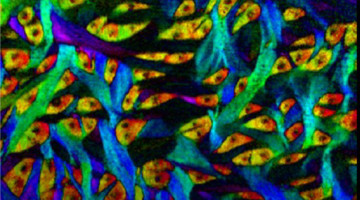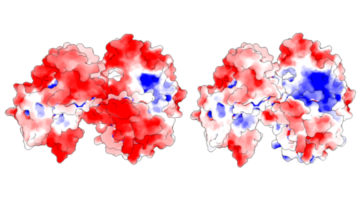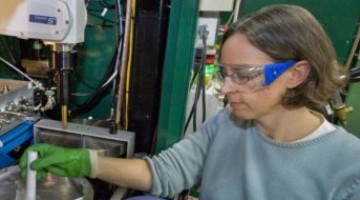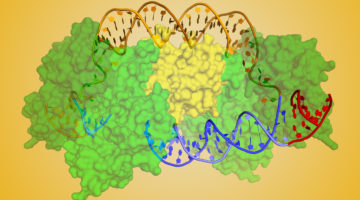Respiratory syncytial virus (RSV) causes serious respiratory disease in infants and older adults, but no vaccine is yet available. Researchers have now determined the molecular structures of human antibodies bound to an RSV surface protein, providing a promising route for designing a vaccine effective against a broad range of RSV strains. Read more »![]()
![]()
Structure-based Design of Pyridone–Aminal eFT508 Targeting Dysregulated Translation by Selective Mitogen-activated Protein Kinase Interacting Kinases 1 and 2 (MNK1/2) Inhibition
Dysregulated translation drives key hallmarks of cancer and is controlled by Phase 2 candidate eFT508 binding to the MNK protein, exploiting stereoelectronic interactions, critical to the compound’s selectivity and potency. Read more »
The Microstructure of a Parrotfish Tooth Contributes to Its Toughness
Parrotfish chew on coral, producing hundreds of pounds of sand each year. Mapping the microstructure of parrotfish teeth, scientists found bundles of crystals interwoven like chain mail. The results provide a blueprint for creating ultra-durable materials for mechanical components that undergo repetitive contact, movement, and abrasion. Read more »
Modified Antibody Clarifies Tumor-Killing Mechanisms
An antibody was modified to activate a specific pathway of the immune system, demonstrating its value in killing tumor cells. The work provides a platform for disentangling different immune-system pathways and could lead to the design of improved immunotherapies. Read more »![]()
![]()
Genentech Advances Research Toward Better Medicines to Lower Cholesterol
Genentech has been working in collaboration with the ALS for years with the goal of identifying a better cholesterol treatment mechanism that targets a cholesterol-regulating protein in the body known as PCSK9. Recent advances in understanding PCSK9’s structure have put them closer to that goal. Read more »![]()
X-Rays Reveal the Biting Truth About Parrotfish Teeth
A parrotfish’s hardy teeth allow it to chomp on coral all day long, ultimately grinding it up through digestion into fine sand. Researchers wanting to see how the fine crystal structure of parrotfish teeth contribute to their incredible strength were able to visualize the orientation of individual crystals, which showed their intricately woven structure. Read more »
X-Ray Footprinting Solves Mystery of Metal-Breathing Protein
Scientists have discovered the details of an unconventional coupling between a bacterial protein and a mineral that allows the bacterium to breathe when oxygen is not available. The research could lead to innovations in linking proteins to other materials for bioelectronic devices such as sensors that can diagnose disease or detect contaminants. Read more »
NIH Grant Will Enhance Structural Biology Research Experience for ALS Users
A recently awarded National Institutes of Health (NIH) grant will help integrate existing structural biology resources at the ALS to better serve users. The funds will help establish a centralized collaborative mechanism, called ALS-ENABLE, that will guide users through the most appropriate routes for answering their biological questions. Read more »
Exploring the Roots of Photosynthesis in a Soil-Dwelling Bacterium
The bacterium, H. modesticaldum, is thought to have a photosynthetic reaction center resembling the earliest common ancestor of all photosynthesis complexes. Its molecular structure has now been solved, providing insight into the evolution of photosynthesis and how nature optimized light-driven energy collection. Read more »
The CRISPR Target-Recognition Mechanism
CRISPR-associated (Cas) proteins have revolutionized gene editing by vastly simplifying the insertion of short snippets of new (“donor”) DNA into very specific locations of target DNA. Now, researchers have discovered how the Cas proteins are able to recognize the target locations with such great specificity. Read more »![]()
![]()
- « Previous Page
- 1
- …
- 15
- 16
- 17
- 18
- 19
- …
- 24
- Next Page »









